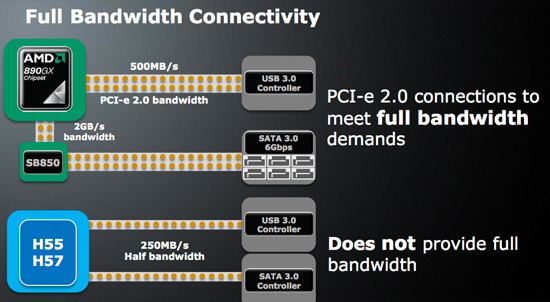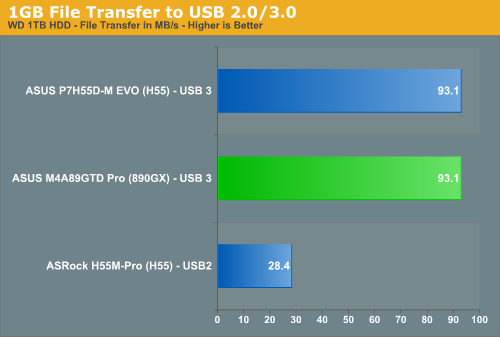AMD's 890GX Chipset - Same Graphics, Better South Bridge
by Anand Lal Shimpi on March 2, 2010 4:36 AM EST- Posted in
- CPUs
Better Suited for USB 3.0?
A little known fact is that Intel’s P55/H55/H57 chipsets run their PCIe lanes at 2.5GT/s. Meaning that a PCIe x1 lane off the chipset only offers 250MB/s in each direction. Aggregate bandwidth is 500MB/s, but that’s only attained if you’re reading at 250MB/s and writing at 250MB/s.

AMD runs all of its PCIe lanes at 5.0GT/s, so a single PCIe x1 slot offers 500MB/s up and 500MB/s down.
Neither AMD nor Intel have integrated USB 3.0 controllers, so they must rely on NEC’s PCIe-to-USB3 controller. AMD’s 890GX chipset offers roughly twice the bandwidth between the chipset and the USB 3 controller.
Today that doesn’t amount to anything. No currently available USB 3.0 peripheral can saturate PCIe 1.0 speeds, but down the road AMD’s approach will avoid any bottlenecks. I’d expect this to start being a problem towards the end of 2010 and into 2011 as we start getting more ONFI 2.0 NAND equipped SSDs that can boast 300MB/s+ read speeds.
USB Performance
No chipset launch article is complete without a never-before-seen problem and we think we hit our quota. We stumbled across an issue using Sharkoon’s USB QuickPort and our ASUS M4A89GTD Pro motherboard; hot-plugging the device into a USB 2.0 port results in a system crash whether you’re in the OS, during POST or within BIOS. The USB 3.0 ports will occasionally work with the drive and we did manage to scramble a quick test (see the graph at the bottom of the page), although the symptoms are largely the same (system hangs, loss of display).
Now, the Sharkoon QuickPort comes with its own power adapter (which it needs to work) and is fully USB 2.0/3.0 compatible, so it should not draw excessive current from the USB ports. There’s always the chance that we’ve got a faulty unit, but bear in mind that it works perfectly with nine motherboards featuring various chipsets.
One thing we noticed is that the M4A89GTD Pro seems to cut power to other USB devices briefly when plug we plug the QuickPort cable into a socket. We tried plugging the drive in while the motherboard is powered down, doing so does allow it to post and enter the OS. After that, Windows finds our USB hard drive and proceeds to load drivers. Trouble is that the drive is not displayed in the ‘My Computer’ menu, and trying to access the drive via the Disk Management snap-in does not work either; we’re continually greeted with a refresh error.
We’re leaning towards the notion of a faulty motherboard at present. ASUS have been notified and have dispatched a new board which should arrive with us shortly. In the meantime, all we’ve got to show for our efforts is 1GB file transfer time over the AMD SB850 vs. Intel’s H55/H57 to the NEC D720200F1 USB 3.0 port using a couple of 1TB Western Digital Caviar hard drives. We know it’s far from an ideal test but will have to suffice for today - sorry folks!

There’s little to divide the boards in a one 1GB file transfer using the SATA HDD’s, it’s obvious that the drives are a bottleneck. We’re aiming to put a couple of 6G SATA drives through their paces on these boards in the near future so we get a better idea of what USB 3 technology can do.










65 Comments
View All Comments
GullLars - Tuesday, March 2, 2010 - link
Since the SB850 also supports RAID, it would be nice to see what the bandwidth and IOPS roof is when RAIDing SSDs. The pictures say 2 GB/s bandwidth, but i'm sceptical. That would put it on par with LSI 9211-4i, only with more ports, so it's possible to reach higher bandwidth with a cheap SATA 3Gbps RAID.Dependent on scaling, you could get about 1200MB/s with x25-V's or 1500+ MB/s with x25-M's, but would the IOPS scale?
I also have a request for a re-run of your 4KB random read numbers for SB750/850 vs ICH10R, as testing at low QD on an vertex LE makes no sense when comparing avalible performance (only accesstime overhead, wich would be better meassured at QD 1). If you redo the test at QD 32, you will see numbers roughly around 150MB/s and then maybe there will be more of a difference than at ~40MB/s, especially when you consider in the additional management overhead of NCQ at higher queue depths. Even indilinx barefoot drives can do 60MB/s 4KB random read at QD 5 (wich according to your traces is within average QD in some scenarios).
sbrown23 - Tuesday, March 2, 2010 - link
I had hoped to see the Cheese Slices thing make another appearance here. Is video playback performance improved at all, or just the same as 790GX?On a side not, does anyone know how the Core i3 HD graphics does with Cheese Slices? Does it look like crap? Wondering if i3 is suitable for a Media Center/streaming media PC.
Tek92010 - Tuesday, March 2, 2010 - link
Hi, ever since the ATI purchase I've been hearing less and less about new nVidia chipsets for the AMD platform. I can understand the issues that they are having competing on the Intel side of the fence however, it really irks me to see them give up on something that they have bein doing so well for so long. In my opinion nVidia still has the best solution on the AMD side - even more so if you're running nVidia graphics.Their USB 2.0 performance, disk performance and AHCI support is up there with Intel's. Their inter-chipset communications speed is up to mark and their IGP performance is acceptable. Not to mention the general stability and maturity of their chipsets and drivers, so why then have they been so quiet on the desktop chipset side for so long?
Why haven't they updated their AMD IGP's to be on par with the excellent Geforce 9300/9400 solutions that they produced for Intel solutions? They had announced upcoming ACC support shortly after AMD started showing off what new tricks it could do with their then new SB750. How long again do we have to wait for that to be implemented?
Can someone who knows please tell me the truth about what nVidia's future chipset plans are on both the AMD and Intel fronts. I am feeling as if I will be forced to make a platform change sooner or later and I really don't want to go with AMD's current solutions until they address their relatively sub-par disk and AHCI performance.
Tek92010 - Wednesday, March 3, 2010 - link
After doing some reading last night I learned that nVidia does have an answer to AMD's ACC out called NCC (nVidia Core Calibration). Apparantly it allows for the same core unlocking and better overclocking on Phenom as AMD's ACC.http://blog.the-odyssey.co.cc/?p=179">http://blog.the-odyssey.co.cc/?p=179
Tek92010 - Wednesday, March 3, 2010 - link
After doing some research last night I discovered that nVidia had in fact released it's own version of AMD's ACC which it calls NCC (nVidia Core Calibration). It's supposed to enable better overclocking as well as core unlocking on Phenom.Paladin1211 - Wednesday, March 3, 2010 - link
Quoted:"until they address their relatively sub-par disk and AHCI performance."
It's not sub-par, mate. USB 3.0 performance is as good as Intel. And with a midrange SSD you'd have the same speed as Intel AHCI, too. Only when you slap in a high end SSD, then it would start to differ.
Given the mass majority of people don't even use a single low-end SSD let alone high-end SSD, the SB850 performs more than good enough. Enthusiasts will at least go for the i7 920 or 860, they don't deal with Phenom II 955 or SB850 either.
Sub-par disk and AHCI performance? You must be joking!
Tek92010 - Wednesday, March 3, 2010 - link
Quoted:"sub·par (sb-pär)
adj.
1. Not measuring up to traditional standards of performance, value, or production.
2. Below par in a hole, round, or game of golf."
The American Heritage® Dictionary of the English Language, Fourth Edition copyright ©2000 by Houghton Mifflin Company. Updated in 2009. Published by Houghton Mifflin Company. All rights reserved.
It's sub-par to me compared to nVidia and Intel chipsets which won't limit my nor my customer's high-end SSD performance. I was never talking about USB 3.0 performance. What qualifies you to make such a broad, generalizing statement about the processor choices of enthusiasts? Why wouldn't an enthusiast build a system with an AMD Phenom II 955 and instead opt for at least the i7 920 or 860, because you said so? The onset of SSD's have shown many people a better way to spend their system budget. Some may now opt for a cheaper and lower performing, "just good enough" processor in order to afford a good performing SSD and might end up with a better overall experience than one with an unbalanced and "mechanical hard disk drive bottlenecked" system.
It is quite posibble to build an excellent gaming system for example, based on the AMD Phenom II 955 and any of the midrange to high end GPU options available today. At high image quality settings the Phenom II 955 will surely be able to provide an acceptable and playable frame rate to many compared to it's i7 920 or 860 counterparts.
Don't forget the whole point of my post. It was really about what is going on at the nVidia camp. If nVidia were to stop making chipsets for AMD then we would all be stuck with something that is not on the same level as Intel in terms of AHCI and general disk performance. If that were to happen then it might push many system builders towards opting for Intel. Not that anything's wrong with that though.
strikeback03 - Wednesday, March 3, 2010 - link
Remember though, AMD isn't looking for just budget shoppers but ideally would like to market to the small number of big spenders too. And those big spenders won't be spending with AMD if the expensive SSD they have bought doesn't work as well.Ryun - Tuesday, March 2, 2010 - link
nVidia isn't making a LGA 1155/1366 board because they don't have a license for the QPI from Intel. Intel is legally blocking them from making chipsets for their new Core i processors (and the new Atom as well), but last I heard there was pending litigation.I don't have a concrete reason for nVidia not making AMD boards anymore, but my guess would be because a) AMD doesn't have a very good product lineup in the mobile segment and that's the one seeing the most growth at the moment. I don't think nVidia wants to invest in a platform that doesn't bring in the dough; and b) nVidia is still upset about AMD buying ATI and creating it's own in-house chipset.
That said, I agree. If I had to choose between ATI and nVidia chipsets I would choose nVidia.
Tek92010 - Tuesday, March 2, 2010 - link
Can you find out nVidia's official position on and reasoning for their lack of AMD chipset innovation and competition Anand?There was a time when the chipset market was very exciting. Are we ever going to return to the glory days of VIA vs SiS vs AMD vs nVidia vs Intel?
Also why haven't you used nVidia chipsets in your testing of AMD platforms for so long? nVidia platforms might actually make them look little better on the benchmarks than their own in-house designs, or are the AMD chipsets better than nVidia's now in your opinion?